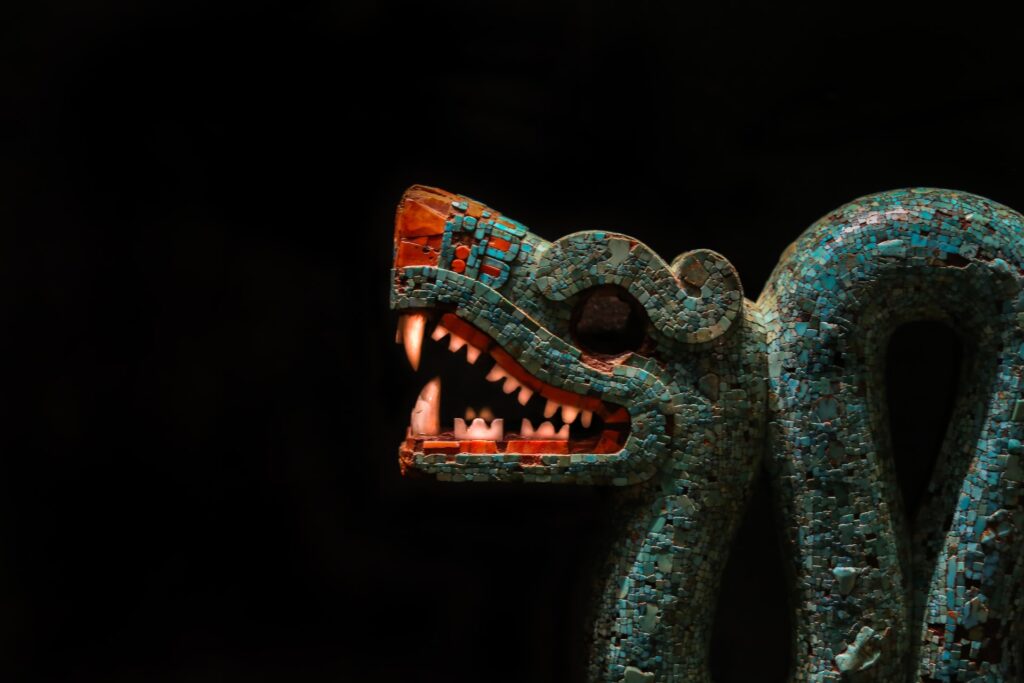
Across the globe, museums are an extremely profitable industry that account for billions of dollars in revenue each year. Ticket sales, philanthropists, and even state funding all aid in financing this industry. But like many profitable industries, museums are often sites of reproduction for the same ideologies rooted in colonialism and inequity that exist outside their doors. This is especially so when it comes to the collections of Indigenous artworks and artifacts found in many museums. Not only are works of Indigenous art often treated solely as anthropological artifacts—rather than legitimate aesthetic pieces—they are also commodities that throw into sharp relief the persistence of white supremacy and colonialism in the museum world.
A recent exchange between the Weltmuseum Wien in Austria and the Mexican government exemplifies the museum as a site of colonialism’s ideological reproduction. As reported by Artnews, Mexico requested to borrow an Aztec headdress from the collection of the Weltmuseum in observance of the 500th anniversary of the Spanish colonization of the Aztec empire. The Weltmuseum refused, citing the fragility of the headdress as constituting too high a risk to ship it to Mexico.
This situation begs the question: to whom does the history of colonialism belong? For centuries, those who took power, land, and resources through violent force have also controlled the legacy of these stories. At the moment those who are wealthy, white, or both, control museums across the globe, either through the staff leadership positions they hold or through philanthropic contributions. According to a 2019 study, 88% of the staff leadership at art museums throughout the US, Canada, and Mexico are white. And it is well known throughout both the US and Europe that those institutions considered among the greatest museums in the world are funded by billionaires. Those who have benefitted the most from the history of colonialism are still in charge of telling the story of colonization across the globe. In fact, key to keeping the colonial project intact is ensuring that no other story is told—which includes denying Indigenous communities the right to steward their own artworks, artifacts, and histories.
The website for Weltmuseum Wien states that the institution “houses some of the most important collections of non-European cultures.” The museum seems to be aware of their particular historical and geographical position in this context, even facing it directly in exhibits like the current Re:Present, in which artists and activists “take an artistic stance on topics such as racism, colonialism and representation of oneself and others in the imperial spaces of the Weltmuseum Wien.”Yet, it is difficult to ignore as the purpose of exhibits such as this one as an attempt to cover over the realities of the museum’s colonial legacy. Indeed, just two months after denying the Mexican government’s request to borrow an important artifact in recognition of their own history, the Weltmuseum is hosting a Día de los Muertos celebration, a programmatic choice that demonstrates how their efforts toward acknowledging colonialism have a long way to go.
Sign up for our free newsletters
Subscribe to NPQ's newsletters to have our top stories delivered directly to your inbox.
By signing up, you agree to our privacy policy and terms of use, and to receive messages from NPQ and our partners.
The situation between the Weltmuseum and the Mexican government is, of course, complicated by the fact that both Austria and Mexico have histories of European colonialism. The major difference is that Mexico is situated on Indigenous land—and is still very much reckoning with the reality of a population that includes Indigenous people, the descendants of Spanish conquistadors, and those who identify as mestiza. Even the task of considering how to mark the 500th anniversary of the Aztec surrender to Spanish forces has proved challenging, as storytellers and citizens alike reckon with whether to celebrate Hernan Cortez’ triumph or mourn the Aztec empire’s defeat.
Under normal circumstances, the museums of Mexico would’ve played an important role in considering this historic moment. But many of them closed at the beginning of the COVID-19 pandemic, and have still been unable to reopen due to severe budget cuts. The lack of resources for these institutions only adds insult to injury when an Austrian museum is still open and thriving, collecting revenue as they invite visitors to see Mexican artifacts and celebrate Mexican holidays.
Though the anniversary for which the headdress was requested has now come and gone, the question of who has the right to steward Indigenous history lingers on. These days, there are renewed demands to return the framing of history and the artworks that make this history tangible to the Indigenous people whose cultures were decimated by colonialism. Many museums are aware of these demands and have made real efforts toward “decolonizing” their collections. Just recently, the Metropolitan Museum in New York returned a statue to Nepal, the latest in a series of artwork repatriations over the last decade. Though these repatriation efforts often return artworks to a government or major institution, they are a first step toward returning important historical artworks and artifacts to Indigenous communities for ongoing stewardship.











